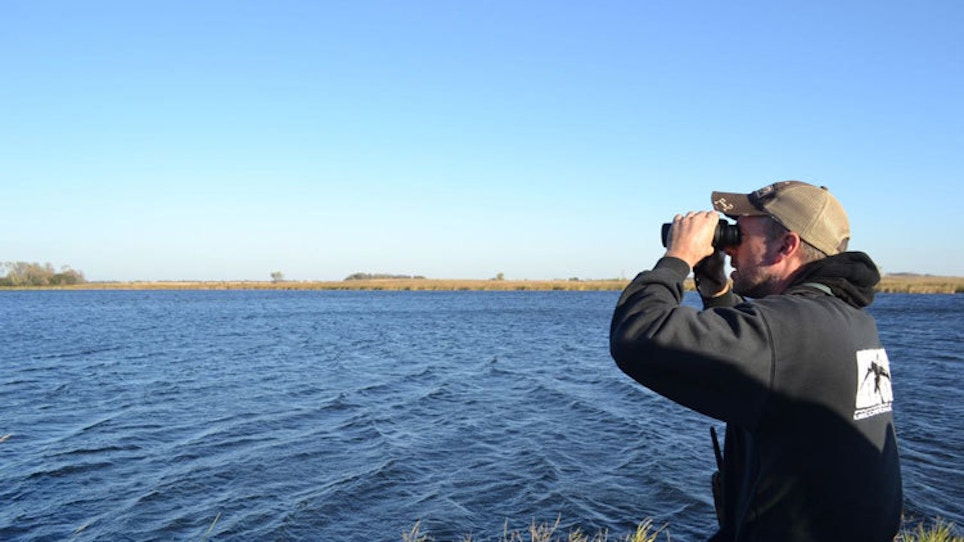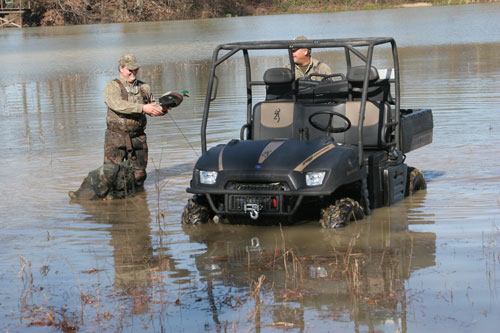Putting in adequate time and effort to properly scout for ducks turns off some gunners. They think it’s wasted energy, since they’d much rather be hunting than looking for places to hunt. I can’t fault them for wanting to spend their time hunting. But proper scouting takes a great deal of skill, and for that reason I enjoy doing it. And in the long run it saves a lot of time and trouble by ensuring you’re only hunting choice places where ducks want to be.
Beasley, Texas, waterfowl guide Dennis Sbrusch does his scouting in late afternoons. He hunts open prairie potholes south of Houston, and his technique is to drive a truck through likely marshlands to carefully scan small lakes and ponds with binoculars. When he locates a choice pond full of ducks, he secures permission to hunt the place from the landowner that night, then takes clients into the spot well before daybreak the next morning.
That same technique has worked well for me during many Canadian duck hunts in Alberta, Saskatchewan and Manitoba. Driving and locating fresh-cut grain fields and checking them with binoculars invariably leads to choice gunning on those fields the next morning. Midday scouting on ponds and lakes can lead to great afternoon hunting. Travel light, just boots, shotgun and shells, and a small bag of decoys. Walk to the pond, jump ducks without shooting, toss out a dozen or so dekes, and shoot them when they come back to the pond.
In many regions, especially in the West and in big river areas where there are hilly “overlooks” (parts of the Mississippi River and the TVA region, among others), hunters can get up on high ground with binoculars to watch where ducks are trading. My brother Marc hunts in Montana, Idaho and Wyoming, where he often gets up on rocky hillsides and mesas overlooking lakes and marshes. Using a powerful spotting scope more suitable to pinpointing mountain goats and elk than ducks, he easily locates choice locations for waterfowling. He’ll typically climb high with his spotting scope in late afternoons, while there’s still good daylight, and choose places on lakes and in marshes where he’ll hunt the following morning. In unfamiliar territory it’s imperative to take careful note of landmarks so hotspots can be found in the next predawn.
Be aware that ducks have feeding, resting and roosting areas. They might visit all such spots in a single day and they might be miles apart. Once, in Washington State, we were hunting a backwater slough off the Columbia River, shooting mallards and having a great time. By 8 a.m. the ducks were done flying into our slough, but we could see them trading far off and above us to the top of a canyon rim. We pulled our duck rig out of the slough and checked the area where the ducks were flying. We found a huge wheat field with a low corner full of water and hundreds of ducks. One of our crew knew the farmer, and that’s where we hunted the next morning. We filled our limits in no time, simply because we noticed birds trading far off and took the time to scout and learn where they were headed, and if we could hunt there.
Some duck hunters charter small airplanes to speed the search for birds. The cost isn’t too excessive, especially when several hunters pool their resources. If you know a pilot who owns a small airplane, often offering to pay for the fuel is all that’s needed to prompt a duck scouting trip. Using a hand-held GPS unit can be helpful in pinpointing hotspots for ducks on big water, like outsize lakes and even oversize marshes, particularly from the air.
Sometimes you’ve got to mark a trail leading into a newly discovered backwater marsh or slough with reflective tape and/or blaze-orange ribbon so you can easily locate the spot before daybreak. It’s wise, too, to mark the hunting location on a detailed topo map of the area, and log GPS numbers right on the map if you’re using that navigation system. Smart phones are a big help in this regard, but double check to make certain you have good cell service in the marsh, or your phone and all its apps do you no good.
Obviously, devotion to duck scouting requires a lot of extra work. Waterfowlers who simply want to hunt for a while in a cozy well-made blind, then head for home, aren’t the type of wingshooters who like to spend a day in a cold and damp marsh, or cruising pothole country by boat, plane or truck. But this kind of all-day scouting for choice locations to gun waterfowl the following dawn pays consistent dividends, and I’ve always enjoyed it because of its impromptu-discovery type fun.
One Florida winter afternoon, for example, after a morning hunt with my friend Bill Sargent of Palm Bay, we drove along the perimeter of a national wildlife refuge looking for ducks. Bill couldn’t hunt the next morning, so I was scheduled to head home that afternoon with my duck boat rig. As we drove along I marked on my topo map where we discovered ducks in quantity. Finally, we stopped at a spot I’d never been to previously, and 200 yards away hundreds of wigeon and teal were rafted in a small marsh lake just off the road.
I checked the map and noted the place was close to the refuge boundary, but in a lawful public hunting spot.
“We can hunt there tomorrow, Bill,” I said to him while watching dozens and dozens of wigeon loafing, diving and feeding at the spot off the road.
“I can’t tomorrow, it’s impossible for me. I’ve got too much work to do at my office.”
I grimaced, picked up my cell phone and called close waterfowl hunting friend Jody Brandenburg 150 miles away in his office.
“Jody, I’ve got ’em. Wigeon, by the hundreds! Sitting in a slough that will give us the best duck hunt you’ve had all season. Can you be here tonight, to hunt tomorrow?”
Jody brought his son, Joel, and in 30 minutes the next morning we had three limits of wigeon.
I’ve never let Bill Sargent live down the fact that he let work interfere with having a great duck hunt. I simply have no tolerance for such a distortion in priorities.
But at least he was there to help with the scouting.







